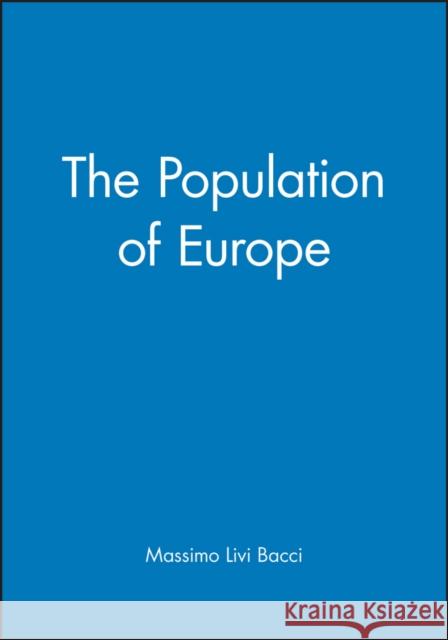The Population of Europe » książka



The Population of Europe
ISBN-13: 9780631218814 / Angielski / Miękka / 2000 / 236 str.
The Population of Europe
ISBN-13: 9780631218814 / Angielski / Miękka / 2000 / 236 str.
(netto: 165,68 VAT: 5%)
Najniższa cena z 30 dni: 172,54
ok. 30 dni roboczych.
Darmowa dostawa!
This book describes the history of the inter-relationships in Europe between population, land, resources, and disease.
Wydanie ilustrowane
"I would most heartily recommend this book to any historian interested in a general overview of the subject"
Reviews in History <!––end––>
"This book is an excellent summation of knowledge and a thoughtful attempt to interpret a thousand years of European history. It will provide useful reading material for students of European population, for experts in the field and for readers everywhere interested in understanding just how Europe came to be the way it is." Journal of Population Research
"In this book, Livi–Bacci manages to link factors which direct the demographic system of a population, and thereby its development, with cultural as well as environmental conditions in a lively and narrative fashion. It is in this way that Livi–Bacci succeeds in giving a complex picture of culture in Europe, customs, behaviours, values and norms. Thus the book is of interest not only for population geographers but for all readers with an interest in Europe." International Journal of Population Geography
"Good Synthetic treatments of European historical demography are scarce, and the publication of Massimo Livi–Bacci′s Population History of Europe is much to be welcomed ... the book can be highly recommended as an introductory/intermediate level student text on European population history, and to non–specialists as a point of entry to the discipline of historical demography." English Historical Review
"A stimulating book, which offers an effective introduction to demographic history for the non–specialist." History
"He has provided an accessible and eminently readable introduction to the population history of Europe ... with a level of insight and penetration that few introductory texts can match ... the work will also attract many historians to the otherwise dauntingly quantitative world of demography." Population Studies
"The Population of Europe provides a masterly volume for the ′Making of modern Europe′ series... a work of great scholarship, drawing extensively from the bulk of demographic research published over half a century or more..." Progress in Human Geography
Preface: Jacques Le Goff.
Part I: Numbers:.
1. Factors of constraint and factors of choice.
2. A millenium of demographic development.
3. Slow change in old regime societies.
4. Interpretive choices.
Part II: Space:.
5. Geography and environment.
6. The conquest of space before the Black Death.
7. Again eastward and southward.
8. Settlement intensification and land reclamation.
9. Consolidation.
Part III: Food:.
10. Population and nutrition.
11. Nutrition, infection, and mortality.
12. Bread and its accompaniments.
13. Famine and hunger.
14. Long–term nutrition and mortality.
15. Paradoxes and reality.
Part IV: Microbes and Disease:.
16. Lives on the brink.
17. A world in motion.
18. The plague: a four–handed game.
19. The final match.
20. Demographic losses.
21. Other factors and the road to normalcy.
Part V: Systems: .
22. Demographic systems.
23. England, France, and Germany.
24. Marriage.
25. Fertility.
26. More on infant mortality.
27. Migration.
28. Equilibrium and transformations.
Part VI: The Great Transformation (1800–1914):.
29. A frame of reference.
30. Demographic expansion: numbers and interpretations.
31. Two months per year: increasing life expectancy.
32. Infant mortality.
33. The advent of birth control.
34. Outside of Europe.
Part VII: The End of a Cycle:.
35. Demography in the twentieth century: mortality and fertility.
36. Demography in the twentieth century: migration, structures, models.
37. Politics.
38. Economics.
39. Values.
Index.
Massimo Livi Bacci is Professor of Demography at the University of Florence. From 1989 to 1993 he was President of the International Union for the Scientific Study of Population. He has taught or held research fellowships at universities all over the world, including the Collège de France, the Colegio de Mexico, Princeton University, University of California at Berkeley, and Brown University. His previous books include A Concise History of World Population (Blackwell, 2nd edition 1996).
Cynthia and Carl Ipsen live in Bloomington, Indiana. Carl Ipsen has also published Dictating Demography: The Problem of Population in Fascist Italy (1996).
This book presents the reader with a fascinating history of the inter–relationships between population, land, resources, and disease in Europe. Professor Livi Bacci integrates the key component of culture to provide a vivid social and narrative history from the first peopling of Europe through centuries of famine, hunger and premature death, up to present–day low mortality, negligible hunger and population stability.
The author focuses on the determinants of epidemics and disease and also on the factors of climate, space and land and their impacts on food and energy supply. The book is accessibly written and translated for the student and general reader. Throughout the book, Professor Livi Bacci brings the human element to the forefront of population history creating an appealing narrative for all interested readers of this subject.
1997-2026 DolnySlask.com Agencja Internetowa
KrainaKsiazek.PL - Księgarnia Internetowa









